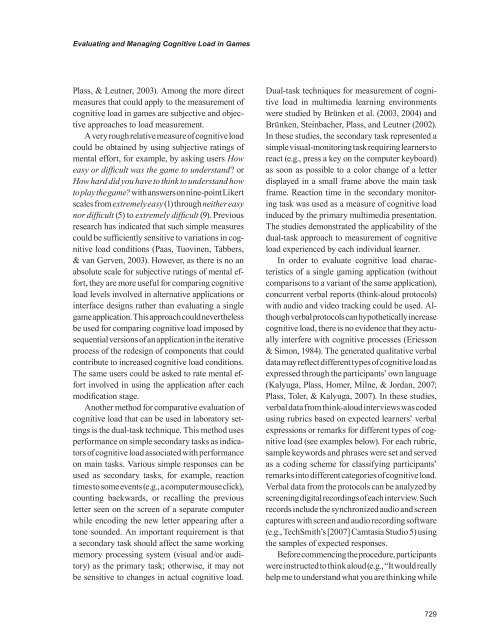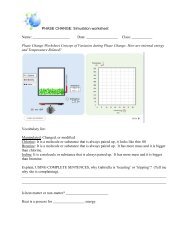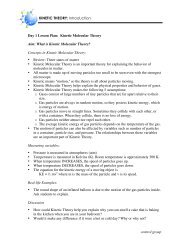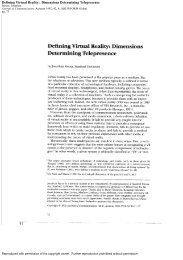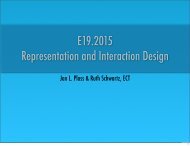Evaluating and managing cognitive load in educational games
Evaluating and managing cognitive load in educational games
Evaluating and managing cognitive load in educational games
Create successful ePaper yourself
Turn your PDF publications into a flip-book with our unique Google optimized e-Paper software.
<strong>Evaluat<strong>in</strong>g</strong> <strong>and</strong> Manag<strong>in</strong>g Cognitive Load <strong>in</strong> Games<br />
Plass, & Leutner, 2003). Among the more direct<br />
measures that could apply to the measurement of<br />
<strong>cognitive</strong> <strong>load</strong> <strong>in</strong> <strong>games</strong> are subjective <strong>and</strong> objective<br />
approaches to <strong>load</strong> measurement.<br />
A very rough relative measure of <strong>cognitive</strong> <strong>load</strong><br />
could be obta<strong>in</strong>ed by us<strong>in</strong>g subjective rat<strong>in</strong>gs of<br />
mental effort, for example, by ask<strong>in</strong>g users How<br />
easy or difficult was the game to underst<strong>and</strong>? or<br />
How hard did you have to th<strong>in</strong>k to underst<strong>and</strong> how<br />
to play the game? with answers on n<strong>in</strong>e-po<strong>in</strong>t Likert<br />
scales from extremely easy (1) through neither easy<br />
nor difficult (5) to extremely difficult (9). Previous<br />
research has <strong>in</strong>dicated that such simple measures<br />
could be sufficiently sensitive to variations <strong>in</strong> <strong>cognitive</strong><br />
<strong>load</strong> conditions (Paas, Tuov<strong>in</strong>en, Tabbers,<br />
& van Gerven, 2003). However, as there is no an<br />
absolute scale for subjective rat<strong>in</strong>gs of mental effort,<br />
they are more useful for compar<strong>in</strong>g <strong>cognitive</strong><br />
<strong>load</strong> levels <strong>in</strong>volved <strong>in</strong> alternative applications or<br />
<strong>in</strong>terface designs rather than evaluat<strong>in</strong>g a s<strong>in</strong>gle<br />
game application. This approach could nevertheless<br />
be used for compar<strong>in</strong>g <strong>cognitive</strong> <strong>load</strong> imposed by<br />
sequential versions of an application <strong>in</strong> the iterative<br />
process of the redesign of components that could<br />
contribute to <strong>in</strong>creased <strong>cognitive</strong> <strong>load</strong> conditions.<br />
The same users could be asked to rate mental effort<br />
<strong>in</strong>volved <strong>in</strong> us<strong>in</strong>g the application after each<br />
modification stage.<br />
Another method for comparative evaluation of<br />
<strong>cognitive</strong> <strong>load</strong> that can be used <strong>in</strong> laboratory sett<strong>in</strong>gs<br />
is the dual-task technique. This method uses<br />
performance on simple secondary tasks as <strong>in</strong>dicators<br />
of <strong>cognitive</strong> <strong>load</strong> associated with performance<br />
on ma<strong>in</strong> tasks. Various simple responses can be<br />
used as secondary tasks, for example, reaction<br />
times to some events (e.g., a computer mouse click),<br />
count<strong>in</strong>g backwards, or recall<strong>in</strong>g the previous<br />
letter seen on the screen of a separate computer<br />
while encod<strong>in</strong>g the new letter appear<strong>in</strong>g after a<br />
tone sounded. An important requirement is that<br />
a secondary task should affect the same work<strong>in</strong>g<br />
memory process<strong>in</strong>g system (visual <strong>and</strong>/or auditory)<br />
as the primary task; otherwise, it may not<br />
be sensitive to changes <strong>in</strong> actual <strong>cognitive</strong> <strong>load</strong>.<br />
Dual-task techniques for measurement of <strong>cognitive</strong><br />
<strong>load</strong> <strong>in</strong> multimedia learn<strong>in</strong>g environments<br />
were studied by Brünken et al. (2003, 2004) <strong>and</strong><br />
Brünken, Ste<strong>in</strong>bacher, Plass, <strong>and</strong> Leutner (2002).<br />
In these studies, the secondary task represented a<br />
simple visual-monitor<strong>in</strong>g task requir<strong>in</strong>g learners to<br />
react (e.g., press a key on the computer keyboard)<br />
as soon as possible to a color change of a letter<br />
displayed <strong>in</strong> a small frame above the ma<strong>in</strong> task<br />
frame. Reaction time <strong>in</strong> the secondary monitor<strong>in</strong>g<br />
task was used as a measure of <strong>cognitive</strong> <strong>load</strong><br />
<strong>in</strong>duced by the primary multimedia presentation.<br />
The studies demonstrated the applicability of the<br />
dual-task approach to measurement of <strong>cognitive</strong><br />
<strong>load</strong> experienced by each <strong>in</strong>dividual learner.<br />
In order to evaluate <strong>cognitive</strong> <strong>load</strong> characteristics<br />
of a s<strong>in</strong>gle gam<strong>in</strong>g application (without<br />
comparisons to a variant of the same application),<br />
concurrent verbal reports (th<strong>in</strong>k-aloud protocols)<br />
with audio <strong>and</strong> video track<strong>in</strong>g could be used. Although<br />
verbal protocols can hypothetically <strong>in</strong>crease<br />
<strong>cognitive</strong> <strong>load</strong>, there is no evidence that they actually<br />
<strong>in</strong>terfere with <strong>cognitive</strong> processes (Ericsson<br />
& Simon, 1984). The generated qualitative verbal<br />
data may reflect different types of <strong>cognitive</strong> <strong>load</strong> as<br />
expressed through the participants’ own language<br />
(Kalyuga, Plass, Homer, Milne, & Jordan, 2007;<br />
Plass, Toler, & Kalyuga, 2007). In these studies,<br />
verbal data from th<strong>in</strong>k-aloud <strong>in</strong>terviews was coded<br />
us<strong>in</strong>g rubrics based on expected learners’ verbal<br />
expressions or remarks for different types of <strong>cognitive</strong><br />
<strong>load</strong> (see examples below). For each rubric,<br />
sample keywords <strong>and</strong> phrases were set <strong>and</strong> served<br />
as a cod<strong>in</strong>g scheme for classify<strong>in</strong>g participants’<br />
remarks <strong>in</strong>to different categories of <strong>cognitive</strong> <strong>load</strong>.<br />
Verbal data from the protocols can be analyzed by<br />
screen<strong>in</strong>g digital record<strong>in</strong>gs of each <strong>in</strong>terview. Such<br />
records <strong>in</strong>clude the synchronized audio <strong>and</strong> screen<br />
captures with screen <strong>and</strong> audio record<strong>in</strong>g software<br />
(e.g., TechSmith’s [2007] Camtasia Studio 5) us<strong>in</strong>g<br />
the samples of expected responses.<br />
Before commenc<strong>in</strong>g the procedure, participants<br />
were <strong>in</strong>structed to th<strong>in</strong>k aloud (e.g., “It would really<br />
help me to underst<strong>and</strong> what you are th<strong>in</strong>k<strong>in</strong>g while<br />
729


